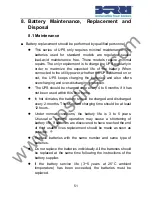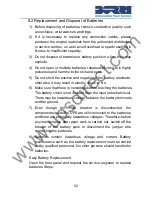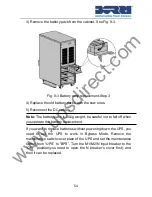
46
5
)
Ensure the UPSs shut down totally. Add the new UPS and reinstall
the new UPS parallel system by following step 1) to 9) of last
chapter - “install a new parallel UPS system”.
6)
Switch on the main input breaker and the main output breaker, and
set the main maintenance switch or static switch from “BPS” to
“UPS”, then set the UPS’s
own maintenance switch from “BPS” to
“UPS” and screw the maintenance cover plate back again. Press
the
button of one UPS, each UPS will start to turn on. After
turning on, the UPSs should work in parallel in the Line mode.
How to remove a single UPS from a parallel system:
1)
First the parallel system must be installed with a main
maintenance mechanical switch or static switch.
2)
Ensure the bypass is normal and the bypass is set to “enable”.
Remove the maintenance switch cover plate on the rear panel of
each UPS. The UPS system will transfer to bypass automatically.
Set the maintenance switch of each UPS from “UPS” to “BPS”.
3)
Set the main maintenance switch or static switch from “UPS” to
“BPS”
. Switch off the main output breaker and the main input
breaker, and the UPS will shut down.
4)
Ensure the UPSs is shut down totally. Remove the UPS and
reinstall the new UPS by following step 1) to 9) of last chapter -
“install a new parallel UPS system”.
5)
If the removed UPS or the remaining UPS will be used in
stand-alone mode, then JP1 and JP2 on the terminal block should
be connected with a short connection wire.
6)
Switch on the main input breaker and the main output breaker,
and set the main maintenance switch or static switch from “BPS” to
“UPS”, then set the UPS’s
maintenance switch from “BPS” to
“UPS” and screw the maintenance cover plate back again. Press
the
button of one UPS, each UPS will start to turn on. After
turning on, the UPSs will work in parallel in the Line mode.
www.upsdirect.com


























